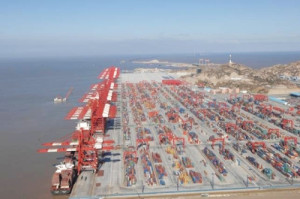
Congestion in different Asian ports last year proved very costly for carriers, shippers, and other industry stakeholders, according to a shipping line executive.
“I am soon reaching 25 years in container shipping, but I’ve got to tell you that 2014 had been the worst year that I have ever experienced in terms of congestion in the ports,” said Tim Wickmann, chief executive officer of MCC Transport, the intra-Asia arm of Danish shipping giant A.P. Moller-Maersk group, during his presentation at last month’s 8th Philippine Ports and Shipping Conference and Exhibit.
Wickmann identified Shanghai and Qingdao in China, Manila, and sometimes even the key hubs of Singapore as well as Tanjung Pelepas in Indonesia as among ports in the region to experience severe congestion and delays last year.
The shipping executive noted different reasons for the traffic backup. At the Manila port, it was due to infrastructure, while in Hong Kong, it was the transfers between the terminals and the hundreds of Chinese barges coming from the River Delta ports. Weather was the usual cause of delays in Shanghai, the world’s busiest container terminal.
Wickmann said that when a port is able to do 30 moves per hour, a shipping line immediately realizes savings of US$100,000 in pure bunker consumption for a fortnightly service. He noted that at the height of the congestion in Manila, productivity dropped to less than 10 moves per hour from the average 25 moves per hour, translating to higher cost.
Aside from bunker, other costs incurred with delays include additional cost of renting a vessel, which can run up to about $10,000 per day.
Due to congestion, Wickmann said MCC had to spend extra for adding two more vessels to serve its customers. In turn, liners imposed congestion surcharges passed on to consignees.
On top of additional costs, Wickmann said delays led to the unpredictable schedules of liners. According to SeaIntel Maritime Analysis, schedule reliability in the container shipping industry dropped to 72.2% in 2014 due to congestion in a number of major ports around the world, including some European and U.S. ports.
For clients and consignees, congestion and delays mean “they cannot maintain any kind of production schedules,” with some forced to ship through airfreight, which is costlier, just to meet their delivery schedules.
To help increase productivity at the terminals, Wickmann said carriers can help terminal operators to plan better. This is by making sure that vessels arrive on time and providing terminal operators the correct number of moves an arriving vessel will require. What is happening now, Wickmann said, is that some carriers tell the operator they need 200 moves per hour when in reality they require 600 moves upon arrival, presenting difficulties for a terminal that normally also has other vessels arriving that day.
One of MCC’s moves to help increase the productivity of a terminal, Wickmann said, is to send their experts from Singapore to terminals for a week or two of meetings “to see what we can do together to make the productivity better.” Wickmann noted that the team sent to Davao Sasa port in Mindanao was very successful in its mission.
The shipping line executive said that with increased productivity and a shorter stay in a port, the longer a vessel stays at sea. The longer it stays at sea, the less speed it needs, and the less oil it spends, oil being the biggest cost of a carrier.
In a February 18 advisory, MCC said Shanghai and Manila’s two international terminals are still congested. Average waiting time for vessels in Shanghai is only one day, while it was two to three days and two days for Manila North and Manila South, respectively. – Roumina Pablo





